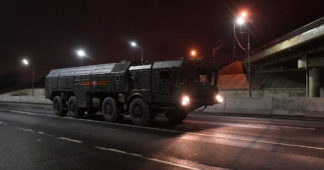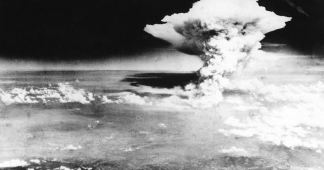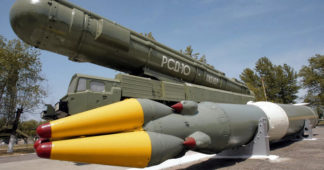In July 1980, U.S. President Jimmy Carter, at the instigation of his National Security Adviser Zbigniew Brzezinski, signed the secret Presidential Directive 59 (PD-59, declassified in 2012) aimed at developing the capacity for fighting a prolonged and limited nuclear war. PD-59 was a plan to decimate the command and control and communications structure of the Soviet Union, along with its nuclear weapons systems, in a counterforce first strike, thus depriving the USSR of second-strike capability. While this secret plan was being put into place, Washington was publicly declaring its intention to install hundreds of intermediate-range Pershing II and cruise missiles in Europe. This was ostensibly in response to the Russian development of a mid-range nuclear missile, the SS-20. But it was actually, as PD-59 indicated, directed at preparing for a “limited” nuclear war, utilizing counterforce weapons and based on the development of a first-strike capability. In December 1979, the U.S. Senate refused to ratify the SALT II Treaty limiting strategic nuclear weapons, ostensibly on the grounds of the Soviet intervention in Afghanistan (a trap for the Soviets initiated by Brzezinski in another secret plan directed at mobilizing the Mujahideen in Afghanistan—with dire long-term consequences that were to stretch into the present century) (“Jimmy Carter’s Controversial Nuclear Targeting Directive PD-509 Declassified” [Documents], Nuclear Vault, National Security Archive, George Washington University, September 14, 2012; William Burr, “How to Fight a Nuclear War,” Foreign Policy, September 14, 2012; “1998 Interview with Zbigniew Brzezinski on Afghanistan in Le Nouvel Observateur,” University of Arizona, dgibbs.arizona.edu).
Carter’s signing of PD-59 was followed soon after by a massive nuclear buildup by the incoming Ronald Reagan administration, part of its Cold War escalation. This focused on the Strategic Defense Initiative (SDI, better known as Star Wars), in which it was claimed that the United States could be protected by an antiballistic missile shield, including various advanced weapons systems, such as particle-beam and space-based weapons. This was discounted by scientists as an unrealizable fantasy, as well as a violation of the 1972 Anti-Ballistic Missile (ABM) Treaty. Accompanying this was the development of the new MX missile, with its mobile basing strategy. U.S. and Soviet scientists in this context were to point to the very real apocalyptic threat of nuclear winter resulting from firestorms in a hundred cities following a thermonuclear exchange, which would lead to the extermination of nearly all of the world’s population (John Bellamy Foster, “‘Notes on Exterminism’ for the Twenty-First Century Ecology and Peace Movements,” Monthly Review 74, no. 1 [May 2022]: 1–17).
The unexpected result of these developments was the sudden emergence of perhaps the largest single, unified protest movement on both sides of the Atlantic in post-Second World War history. In the early 1980s, a trans-Atlantic antinuclear movement drawing the support of tens of millions of people suddenly arose seemingly out of the very ground. In Europe, this took the form of massive protests against the deployment of intermediate-range nuclear missiles on European soil. In the United States, the nuclear freeze movement emerged, aimed at stopping the escalation of U.S. and Soviet nuclear weapons deployments.
It is often claimed in official channels that both wings of the movement, in Europe and the United States, failed. The European antimissile movement was unable to prevent U.S. deployment of Pershing II and cruise missiles in Western Europe. The nuclear freeze movement in the United States was likewise unable to stop the Reagan administration from going forward with its overall nuclear escalation. The official story of the state and corporate media is that it was Reagan’s policy of negotiating from strength that eventually forced Mikhail Gorbachev to make startling concessions, which led to the Intermediate-Range Nuclear Forces (INF) Treaty in 1987 and the beginning of the end of the Cold War. (Parts of this and the next paragraph are taken from John Bellamy Foster, “Why Movements Matter,” American Journal of Sociology 108, no. 2 [September 2, 2002]: 509–10; see also Steve Breyman, Why Movements Matter: The West German Peace Movement and U.S. Arms Control Policy [Albany: State University of New York Press, 2001].)
Nothing, however, could be further from the truth. The antinuclear movement of the 1980s was a volcanic wave that was ultimately irresistible. In West Germany, the peace movement gained the support, if limited, of the Social Democratic Party, the nation’s largest political party. The antinuclear struggle was also largely responsible for the emergence of the German Greens as a political force. By 1983, 70 percent of the West German population were opposed to Euromissile deployment and 80 percent of the U.S. population supported a nuclear freeze. The leading figure in the movement for European Nuclear Disarmament (END) in Britain, was Marxist historian E. P. Thompson, author of The Making of the English Working Class, whose antinuclear manifesto Protest and Survive was published in the United States by Monthly Review Press. It was the gargantuan scale of the movement in both Europe and the United States, and the extremely sane nature of the demands put forth, that enabled Gorbachev to push nuclear arms control forward, leading to the INF Treaty in 1987. Although the Pentagon’s 1984–1988 Defense Guidance document leaked at this time declared that the United States would “prevail” in a nuclear war, Reagan, under pressure from the nuclear freeze movement supported by almost the entire U.S. population, was compelled to back down, conceding that a nuclear war could never be won. It was not the Reagan administration’s Cold War belligerence that made progress on arms control possible, but rather the revolt from below (E. P. Thompson and Dan Smith, eds. Protest and Survive [New York: Monthly Review Press, 1981]; Christos Efstathiou, E. P. Thompson: A Twentieth-Century Romantic [London: Merlin Press, 2015], 116–65; Daryl G. Kimball, “Looking Back: The Nuclear Arms Control Legacy of Ronald Reagan,” Arms Control Association, July 2004).
Yet, for nuclear strategic planners, the INF Treaty was looked upon as a major obstacle to the dominant U.S. counterforce strategy and Washington’s quest for nuclear primacy. Moreover, a first strike or counterforce strategy needs to be backed up by antiballistic missile systems, which, although useless in stopping a full nuclear attack, could theoretically pick off any remaining missiles that had survived the first strike against a nuclear foe. Here, the ABM Treaty was seen as standing in the way of U.S. nuclear strategy. Following the demise of the Soviet Union, the United States sought to consolidate its position as the unipolar world power. In 2001, George W. Bush unilaterally withdrew the United States from the ABM Treaty. In 2019, Donald Trump followed suit by unilaterally withdrawing from the INF Treaty, alleging that Russia had transgressed the agreement, which prohibited development and testing of ground-based missiles with a range of between 500 and 5,500 kilometers (between 311 and 3,418 miles). Moscow denied the charge, indicating that the particular missile in question, the Novator 9M729, had a range of only 479 kilometers (298 miles). Moscow claimed that NATO had broken the INF Treaty with the installation of missile defense systems in Poland and Romania under the Barack Obama administration that had the well-known capability of launching offensive weapons, notably Tomahawk cruise missiles armed with nuclear warheads. Nevertheless, Washington refused to enter negotiations, walking out of the INF Treaty (Delphi Initiative, “Western Capitalists Are Drawing Humanity into Nuclear Annihilation. Stop Them!,” Defend Democracy Press, July 11, 2024).
In April 2024, a mere five years after Washington’s unilateral withdrawal from the INF Treaty, the United States began its deployment of previously banned ground-based intermediate-range strategic missiles in the Philippines, targeting China. This includes Tomahawk cruise missiles with a range of 2,414 kilometers (1,500 miles), able to reach the East coast of China, the Taiwan Strait, and People’s Liberation Army bases in China, and equipped to carry nuclear as well as conventional warheads (John Bellamy Foster and Brett Clark, “Imperialism in the Indo-Pacific—An Introduction,” Monthly Review 76, no. 3 [July–August 2024]: 12–13).
Washington then turned to the European theater. On July 10, 2024, during the NATO Summit in Washington, a joint statement was issued by the United States and Germany that SM-6 Tomahawk cruise missiles—with a range and a speed allowing them to strike Moscow in a few minutes if located on German soil—would be deployed in Germany beginning in 2026. These missiles are to be followed by the Long-Range Hypersonic Weapon (LRHW, still in the developmental stage), with a range of 2,736 kilometers (1,700 miles) and a much faster speed. Although it is specified in the Joint Agreement that the Tomahawk and LRHW missiles are to be “conventional,” that is, carrying conventional warheads, they are at the same time, dual purpose, nuclear-capable missiles. Such missiles when carrying conventional warheads, moreover, fall in the class of “strategic non-nuclear weapons.” Due to precision targeting, they are able to destroy hardened targets, such as in silos for Intercontinental Ballistic Missiles and nuclear command centers, thus playing a strategic role in a counterforce first strike. Washington’s Prompt Global Strike (also known as Conventional Prompt Strike) initiative is aimed at multiplying such strategic missiles armed with conventional warheads to strike “high payoff targets,” particularly targeting nuclear weapons and command and control systems in a counterforce attack. In late July 2024, following the NATO Summit, the United Kingdom and Germany indicated that they were engaged in talks on a joint partnership to develop a “conventional” intermediate-range hypersonic missile with a range of 3,200 kilometers (1,988 miles) targeting Russia (White House, “Joint Statement from United States and Germany on Long-Range Fires Deployment in Germany,” press release, July 10, 2024; Fabian Hoffmann, “Strategic Non-Nuclear Weapons and Strategic Stability,” Fondation pour la Recherche Stratégique, November 2021, frstrategie.org; “Mad Nuclear Plans,” Defend Democracy Press, July 26, 2024; “UK Considers Long-Range Missiles to Counter Putin’s Nuclear Threat,” The Times [London] July 25, 2024; Congressional Research Service, “Conventional Prompt Global Strike and Long-Range Ballistic Missiles,” July 16, 2021).
The ground-based intermediate-range missile systems or “fires” deployed by the United States in the Indo-Pacific and European theaters (along with their air and sea counterparts) are, therefore, currently perceived in nuclear strategy circles as counterforce weapons. Once placed in Germany, the Tomahawk cruise missiles and LRHW—along with the future UK-German intermediate-range hypersonic missiles—offer the potential for the “decapitation” of the Russian leadership in a first strike. In this respect, they add a powerful complement to the already deployed U.S. nuclear forces in Europe “shared” with NATO, armed with the B61-12 nuclear bomb, and to existing British and French nuclear capabilities in Europe. Washington, as previously indicated, has also placed missile defense systems in Poland and Romania that can double as offensive systems launching nuclear-armed cruise missiles. In contrast, Moscow, with its more traditional approach to nuclear weapons strategy, which still relies mainly on a nuclear posture of Mutual Assured Destruction (MAD), has not yet deployed any ground-based intermediate-range strategic missiles this century, although it is now suggesting that it may develop and deploy this previously banned class of missiles in response to this growing threat from NATO. All of this portends a rapidly escalating danger of a Third World War (Andrew Osborn, “Russia to Counter ‘Threatening’ Deployment of Long-Range Missiles in Germany,” Reuters, July 11, 2024; “Russia Defends New Cruise Missile Test that U.S. Says Violates INF Nuclear Treaty,” CBS News, January 23, 2019; Delphi Initiative, “Western Capitalists Are Drawing Humanity Into Nuclear Annihilation. Stop Them!”).
Even madder than MAD—the nuclear posture supported by the minimalists in the nuclear strategy debate—the counterforce strategy supported by the maximalists, is sometimes referred to as NUTS (for Nuclear Utilization Target Selection). It won out after the fall of the Soviet Union and has continued to determine U.S. nuclear strategy ever since. Today’s U.S. nuclear deterrence posture is meant to complement a strategy of NATO enlargement (also formulated notably by Brzezinski) crucial to the development of nuclear primacy or the ability to carry out a counterforce first strike. The stated purpose of a counterforce strategy is to make nuclear weapons usable in the pursuit of political ends by supposedly removing the threat of MAD in a nuclear war. The fact that all realistic analyses (including those of the Pentagon) see a so-called limited nuclear war as inevitably escalating out of control is set aside by U.S. strategy in this quest for world nuclear primacy. From a reasoned perspective, the most likely path to total nuclear annihilation worldwide is in fact the delusion of a prolonged and limited nuclear war (John Bellamy Foster, “The U.S. Quest for Nuclear Primacy,” Monthly Review 75, no. 9 [February 2024]: 1–21).
This Madder than MAD strategy, currently being expedited by a declining empire, should have the whole world in a state of alarm. Still, if history today is repeating itself in the U.S. deployment of intermediate-range nuclear weapons in Europe and Asia, there remains the possibility of another volcanic movement from below erupting in the cause of world peace and the survival of humanity—as in the 1980s. Exterminism, as Thompson taught, is a tendency of the capitalist system. It is not the inevitable fate of humanity (E. P. Thompson, Beyond the Cold War [New York: Pantheon, 1982], 41–80).
* * *
Associate editor of Monthly Review Brett Clark, in what must be something of a record, was the recipient in 2024, in a single year, of the top awards of two different sections of the American Sociological Association. He received the Distinguished Contribution Award (the career award) of the Environmental Sociology Section of the American Sociological Association (ASA), designating him as a leading contributor to environmental sociology in our time, not only in the United States but worldwide. At the same time, he was honored with the 2024 Lifetime Achievement Award of the Section on Marxist Sociology of the ASA, due to his leadership as a contributor to Marxist sociology. Double congratulations, Brett!
Editorial Monthly Review September 2024
We remind our readers that publication of articles on our site does not mean that we agree with what is written. Our policy is to publish anything which we consider of interest, so as to assist our readers in forming their opinions. Sometimes we even publish articles with which we totally disagree, since we believe it is important for our readers to be informed on as wide a spectrum of views as possible.











